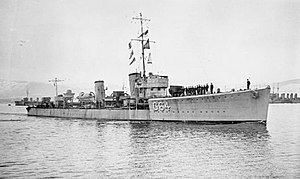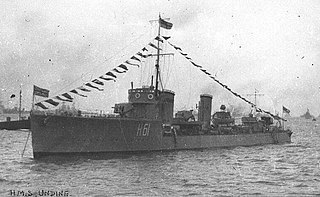
HMS Ursa was a modified Admiralty R-class destroyer that served in the Royal Navy during the First World War. The Modified R class added attributes of the Yarrow Later M class to improve the capability of the ships to operate in bad weather. Launched in 1917, the vessel saw service as part of the Grand Fleet. The destroyer took part in the Second Battle of Heligoland Bight while being commanded by Commander John Tovey, who later became Admiral of the Fleet and led the successful action against the battleship Bismark. The vessel was also one of the first destroyers to launch a torpedo at the enemy during the battle. After the war, Ursa was transferred to the Home Fleet, but was sold to be broken up in 1928.

HMS Ursula was a Modified Admiralty R-class destroyer that served in the Royal Navy. The Modified R class added attributes of the Yarrow Later M class to improve the capability of the ships to operate in bad weather. The vessel was launched in 1917 at Greenock in Scotland and served with the Grand Fleet during the First World War. After the war, the destroyer was transferred to the Home Fleet, but then moved to the Reserve Fleet. In 1924, Prince George served aboard Ursula before, in 1929, the vessel was sold to be broken up.

HMS Raider was the second of a class of sixty two R-class destroyers operated by the Royal Navy. Launched in 1916, the vessel served with the Grand Fleet during World War I. The destroyer was built as part of the preceding M-class but was equipped with geared turbines which improved efficiency and increased range. The ship was involved in anti-submarine patrols, but did not sink any German submarines. After the war, the destroyer initially moved to Harwich and was briefly stationed in Ireland after the Irish Civil War. In 1923, the Navy decided to retire the older destroyers in the fleet and, although initially spared, Raider was decommissioned and sold to be broken up in 1927.

HMS Sarpedon was an R-class destroyer which served with the Royal Navy. The R class were a development of the preceding M-class, but differed in having geared turbines and other design changes. Launched in June 1916, the vessel escorted convoys that sailed between Scotland and Scandinavia in the First World War. After the war, the ship was allocated to local defence at Nore. However, in 1923, the Navy decided to retire many of the older vessels and Sarpedon was retired and was sold to be broken up on 23 June 1926.
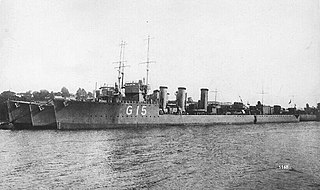
HMS Rowena was an R-class destroyer which served with the Royal Navy during World War I. Launched on 1 July 1916, the ship operated as part of the Grand Fleet as part of a destroyer flotilla hunting for German vessels that were attacking convoys in the North Sea. Although there were many reported sightings, no submarines were sunk. After the conflict, the vessel was transferred to the Navy’s establishment at Portland to help in the development of anti-submarine warfare, which ultimately helped in the Battle of the Atlantic. Rowena did not, however, see the fruit of this labour. After twenty years of service, the destroyer was retired and sold to be broken up on 27 January 1937.

HMS Tobago was a Thornycroft S-class destroyer which served with the Royal Navy during the Greco-Turkish War. Launched by Thornycroft on 15 July 1918, the vessel followed a design typical of the yard by being faster than the majority of the class, and also had better seakeeping properties thanks to a raised forecastle. The destroyer operated as part of the Grand Fleet for the last few weeks of the First World War, and, after the Armistice, joined the Mediterranean Fleet based in Malta. While serving in off the coast of Turkey, the ship hit a mine on 15 July 1920, exactly two years after being launched. Despite the relative youth of the vessel, the damage was deemed irrepairable and so Tobago returned to Malta and was sold for scrap on 9 February 1922.

HMS Tourmaline was a Thornycroft S-class destroyer, which served with the Royal Navy during the Greco-Turkish War and the Russian Civil War. Tourmaline was one of three destroyers ordered from Thornycroft in June 1917 with more powerful geared turbines than the majority of the class as well as design changes that improved seakeeping. Launched on 19 April 1919, the vessel operated as part of the Fourth Destroyer Flotilla serving with the Atlantic and Mediterranean Fleets. After serving in the Black Sea and Sea of Marmara, during which sister ships Speedy and Tobago were lost, Tourmaline led the Gibraltar Local Defence Flotilla. The London Naval Treaty, signed 1930, required the retirement of some destroyers to meet the Royal Navy's tonnage requirement and Tourmaline was chosen for retirement. The destroyer was decommissioned on 28 November 1931 after 12 years of service and broken up.
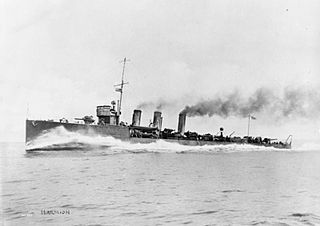
HMS Maenad was an Admiralty M-class destroyer which served with the Royal Navy during the First World War. The M class were an improvement on the previous L class, capable of higher speed. The vessel, launched in 1915, served in the Battle of Jutland in 1916, attacking both battleships and destroyers of the German High Seas Fleet. However, the vessel was notorious for undertaking a sharp manoeuvre which obstructed other destroyers in the fleet from attacking. Maenad also undertook anti-submarine patrols. In 1917, the ship mistakenly attacked the British submarine G12 thinking it was a German boat. The submarine escaped with damages. After the armistice that ended of the war, Maenad was placed in reserve until being sold to be broken up in Germany in 1921.

HMS Tara was an S-class destroyer, which served with the Royal Navy. Launched on 7 August 1918, the vessel entered service at the closing of the First World War. The ship joined the Fourteenth Destroyer Flotilla of the Grand Fleet but was placed in Reserve at Nore in 1919. Tara deteriorated over the following years and was sold to be broken up on 17 December 1931 after the signing of the London Naval Treaty that limited the amount of destroyer tonnage the Navy could retain.
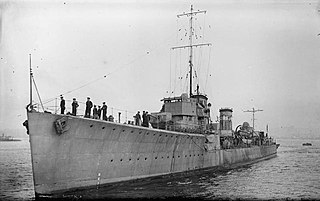
HMS Serapis was an S-class destroyer, which served with the Royal Navy during the Greco-Turkish and Russian Civil Wars. Launched on 17 September 1918, the vessel was not completed until after the closing of the First World War. The ship joined the Seventh Destroyer Flotilla in the Reserve Fleet at Rosyth. The ship was then commissioned and sent to Constantinople to support refugees escaping from the conflicts in the Black Sea. The destroyer assisted in the evacuation of the Crimea in 1919 and helped rescue about nine hundred people from Smyrna in 1922. In 1929, Serapis was transferred to Hong Kong to serve in China. However, the signing of the London Naval Treaty in 1930 meant that the Royal Navy looked to retire older vessels. Serapis was sold to be broken up on 25 January 1934.

HMS Tribune was an S-class destroyer that served with the Royal Navy during the Russian Civil War. Launched in 1918, the vessel entered service with the Aegean Squadron of the Mediterranean Fleet. Tribune saw no action during the First World War but was involved in supporting the evacuation of refugees from the Russian Civil War, particularly from Crimea in 1920 and 1921. The ship also visited Constantinople in 1920 and 1922 during the Turkish War of Independence. In 1923, the destroyer was transferred to the Atlantic Fleet. In 1929, the ship took part in simulated amphibious warfare with the Territorial Army. In 1930, the signing of the London Naval Treaty required the Royal Navy to retire older destroyers before acquiring new ones. Tribune was one of those chosen for retirement and, in 1931, the destroyer was sold to be broken up.

HMS Trinidad was an S-class destroyer that served with the Royal Navy. The ship was named after the island in the West Indies. Launched on 8 May 1918, the vessel entered service with the Grand Fleet but saw no action during the First World War. After the Armistice, Trinidad joined the Mediterranean Fleet. War had broken out between Greece and Turkey and there was intelligence that the Soviet Union was selling warships to one of the belligerents. Trinidad was part of a small flotilla that was sent to investigate and, ultimately, halt this trade. However, it turned out to be a hoax. The destroyer subsequently returned to Constantinople. In 1930, the signing of the London Naval Treaty required the Royal Navy to retire older destroyers before acquiring new ones. Trinidad was one of those chosen for retirement and, on 16 February 1932, the destroyer was sold to be broken up.

HMS Seraph was an S-class destroyer, which served with the Royal Navy during the Russian Civil War. The S class were a development of the previous R class, with minor differences, constructed at the end of the First World War. Seraph had a career as an evacuation vessel more than as a warship. Launched in 1918 by Denny, Seraph was originally destined for the Grand Fleet but, after the Armistice, the destroyer transferred to the Mediterranean Fleet based at Malta. The destroyer was sent into the Black Sea to support the White Russian forces in their fight against the Communists. The role involved supporting the movement of troops rather than firing at the enemy. Ultimately, the Communists won and Seraph helped the evacuation of White Russian troops from Crimea, returning to Malta in 1921. The destroyer was then stationed in the Eastern Mediterranean in 1923 in response to the tensions in Turkey. In 1927, the ship was sent to Hong Kong to serve under the Commander-in-Chief, China. In 1929, the vessel was once again called to evacuate, this time Christian missionaries from the Chinese Red Army. Once again, the evacuation took place without bloodshed. With the introduction of more modern destroyers, the Royal Navy started retiring the S class and, in 1934, Seraph was sold to be broken up.

HMS Sesame was an S-class destroyer, which served with the Royal Navy in the twentieth century. Launched on 30 November 1918 just after the end of the First World War, the ship was commissioned into the Reserve Fleet. A year later, the destroyer was sent to Latvia in support of the country's call for independence, arriving just at the cessation of that county's war of independence. Returning to the United Kingdom, Sesame was later equipped to act as a plane guard within the Home Fleet, with all armament removed and a davit fitted to rescue aircraft. The vessel remained in that configuration for a short time, but the London Naval Treaty sounded the death knell for the ship as it limited the destroyer tonnage that the Royal Navy could operate. As newer and more powerful destroyers entered service, Sesame was one of those retired, being sold to be broken up on 4 May 1934.

HMS Mameluke was an Admiralty M-class destroyer which served with the Royal Navy during the First World War. The M class was an improvement on the preceding L class, capable of higher speeds. The ship, the first Royal Navy vessel to be named after the Mamelukes, a class of ex-slaves that ruled Egypt, was launched in 1915. The destroyer joined the Twelfth Destroyer Flotilla and, although under refit during the Battle of Jutland and so unable to participate, later took part in anti-submarine operations as part of this flotilla, although no submarines were sighted or sunk. The conditions of service in the North Sea meant that the destroyer was soon worn out and, after the armistice, Mameluke was placed in reserve. Despite a service life of only six years, the vessel was decommissioned and, in 1921, sold to be broken up.

HMS Scotsman was an S-class destroyer that served with the Royal Navy during the Russian Civil War. The S class was a development of the previous R class, with minor differences, constructed at the end of the First World War. Scotsman was completed in May 1918 and joined the Grand Fleet for the last few months of the War. The destroyer then joined the British campaign in the Baltic, sailing as part of a detachment of ten destroyers under the command of Admiral Walter Cowan in March 1919. Scotsman provided military and humanitarian assistance to the Latvian cities of Liepāja and Ventspils in April 1919. On returning to the UK, the ship was placed in reserve, initially at Rosyth and later Devonport. The destroyer remained in reserve until, in July 1937, Scotsman was sold in part-exchange for the liner Majestic and broken up.

HMS Seabear was an S-class destroyer that served with the Royal Navy during the Russian Civil War. The S class was a development of the previous R class, with minor differences, constructed at the end of the First World War. Seabear was launched in December 1917 and joined the Grand Fleet for the last few months of the War. The destroyer then joined the British campaign in the Baltic, sailing as part of a detachment of ten destroyers under the command of Admiral Walter Cowan in March 1919. Seabear sailed to Tallinn in support of the Estonian War of Independence the following month. On returning to the UK, the ship was placed in reserve. The London Naval Treaty limited to number of destroyers that the Royal Navy could operate and, as new ships entered service, older vessels were retired. Seabear was sold in February 1931 and broken up.

HMS Sirdar was an Admiralty S-class destroyer that served with the Royal Navy during the Turkish War of Independence. The S class was a development of the R class created during the First World War as a cheaper alternative to the V and W class. Launched in 1918 just before the Armistice, the ship initially joined the Grand Fleet but was swiftly transferred to reserve when the war ended. After a short period based in Rosyth, the destroyer was transferred to the Mediterranean Fleet at the end of 1919 in time for the Turkish War of Independence. The vessel helped British and Ottoman forces defend the town of Izmit and to escort the Turkish battlecruiser Yavuz Sultan Selim to Tuzla. The destroyer was subsequently deployed to the China Station. Between 1927 and 1931, Sirdar was involved in combatting piracy, including helping the crew of the passenger ship Hatching defeat 25 pirates that had secreted themselves amongst the passengers. In 1930, the destroyer was fired on by members of the Chinese Red Army while cruising along the Yangtze. The signing of the London Naval Treaty that year meant that the Royal Navy needed to decommission older destroyers as new vessels entered service. In 1934, Sirdar was retired and sold to be broken up.

HMS Tintagel was an Admiralty S-class destroyer that served with the Royal Navy in the Second World War. The S class was a development of the R class created during the First World War as a cheaper alternative to the V and W class. Launched in 1918 shortly after the Armistice, the ship was commissioned into the Fourteenth Destroyer Flotilla of the Grand Fleet. However, the end of the war meant that destroyers were not needed in the front line to the same extent and Tintagel was recommissioned into the Reserve Fleet a year later. Between 1920 and 1921, the ship served with the torpedo school at Sheerness. In 1924, the vessel accompanied the submarine X1 on sea trials. After the London Naval Treaty of 1930, and the subsequent reduction in the Royal Navy's older destroyer force, Tintagel was retired and, in 1931, sold to be broken up in Plymouth.
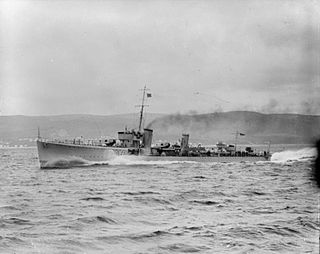
HMS Stormcloud was an Admiralty S-class destroyer that served with the Royal Navy during the twentieth century. The S class was a development of the R class created during the First World War as a cheaper alternative to the V and W class. Launched after Armistice that ended the war, the ship was commissioned in 1920 and initially joined the Fourth Destroyer Flotilla before moving to the Eighth Destroyer Flotilla in 1925. In 1927, the ship moved to Hong Kong and served to prevent piracy in the seas between Hong Kong and Saigon and also to rescue those who had suffered from pirates attacking their ships. Following the signing of the London Naval Treaty, the destroyer was retired and, in 1934, sold to be broken up.
